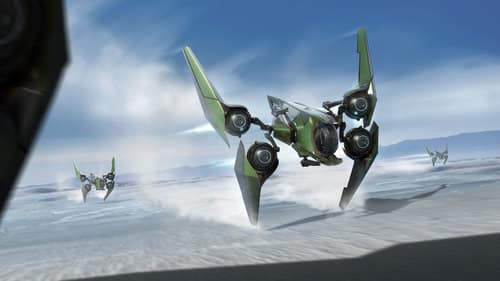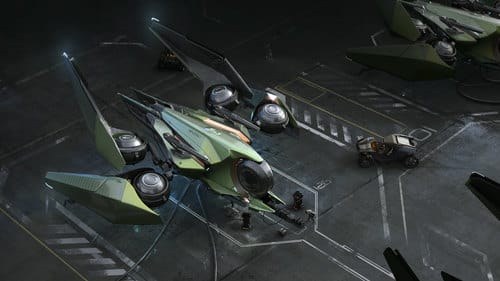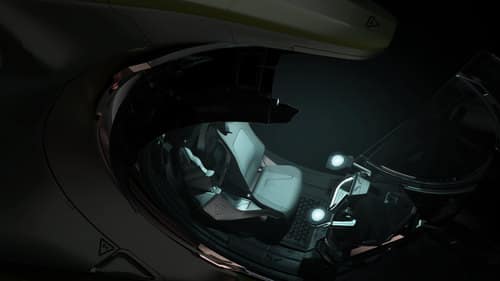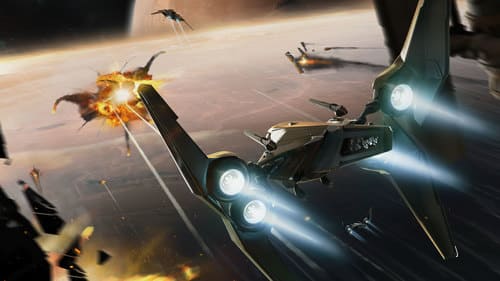Q&A: Aopoa San’tok.yāi
Following the launch of the San’tok.yāi from Aopoa, we took our questions to the ship designers to give you more information on this recently-unveiled medium class fighter.
Special thanks to John Crewe and Todd Papy for answering our questions.

What can the San’tok.yāi do that the Khartu-al cannot and vice versa? What are the advantages and disadvantages? What are the main differences?
In the Xi’an order of battle, the Khartu-al serves principally as a light fighter, scout, and skirmisher, whereas the San’tok.yāi is a medium fighter and direct combatant. Just like the UEE Military, the Xi’an military employs various types of fighters with different strengths and performance characteristics. The comparison between a Khartu-al and a San’tok.yāi is similar to the comparison between a Gladius and a Hornet – one emphasizes firepower and the other emphasizes speed and agility. Particularly due to its lower mass and lighter weapons complement, the Khartu-al is faster, accelerates more quickly, and is even more responsive than the San’tok.yāi. However, the San’tok.yāi carries considerably more weaponry. That said, the Khartu-al and San’tok.yāi are both Xi’an designs through and through, set apart from other fighters by the exceptional maneuverability afforded to them by their distinctive maneuvering rigs. In the hands of a capable pilot well-versed in the ship’s capabilities, the San’tok.yāi is a difficult target. The Khartu-al, maddeningly so.
Is this a true Xi’an military ship or a civilian export?
Similar to the Khartu-al, the San’tok.yāi is a civilian version of the Xi’an military ship designed for export and sale in the Human market. Like the Khartu-al, the San’tok.yāi is an original Xi’an-produced export by Aopoa, and not a replica, reconstruction, or a product of reverse-engineering.
How does this ship handle, maneuverability wise?
In terms of maneuverability, the San’tok.yāi is one of the best-handling ships of its size and weight class – in this case, the proper point of comparison is other medium fighters, such as the Hornet or Sabre. The design of Xi’an fighter craft revolves around their unique thruster configuration, which relies on highly articulated main thrusters. When compared with the typically human thruster setup, which relies on one or more main fixed thrusters with yaw, pitch, and roll delivered through additional small maneuvering thrusters, the Xi’an approach provides superior strafe-movement capabilities and lateral acceleration. The ability to deliver main engine performance on multiple axes also affords some other benefits. For example, many ships have finite VTOL endurance or exert heavy wear on their maneuvering thrusters while engaged in VTOL. Xi’an fighters, like the San’tok.yāi, barely notice such activity, it being nearly as natural to them as forward flight.
Will the Xi’an tech that introduces this new strafing maneuverability be applied to any other ships?
Theoretically it’s possible, but it will likely remain exclusive to Xi’an ship designs. While Xi’an thruster technology plays a large part in delivering this unique strafing flight capability, the overall design of the ship’s entire spaceframe and power infrastructure is also integral to providing the full range of articulation and point reinforcement needed to utilize it to its fullest. It is not something that can be effectively or efficiently retrofitted to ships not designed with them in mind from the ground up. Furthermore, the resulting structural arrangement, with main thrusters located outside the ship’s main fuselage and borne articulation joints that may be exposed from multiple angles, is less durable under fire than contemporary ‘bricky’ human designs. Xi’an engineers still make their fighters as strong and durable as they can without compromising the ship’s other capabilities, but this requires accounting for these requirements from the get-go. An attempt to retrofit a Xi’an thruster rig to a ship that wasn’t designed with one in mind from the start would result in something downright rickety.
Is this a common ship in the Xi’an empire?
As a mainstay medium fighter in the arsenal of the Xi’an Empire, the San’tok.yāi is about as common a sight in Xi’an space as a Hornet or Sabre would be in UEE space. It serves prominently in the Xi’an fleet and may also occasionally be found serving civilian security forces of some of the more powerful Xi’an houses.
Are we getting any cool Xi’an weapons? Xi’an missiles maybe?
The Yeng’tu S3 Laser Repeater that comes with the San’tok.yāi is manufactured by Torral Aggregate and uses Xi’an technology to provide a higher rate of fire than traditional human-produced laser repeaters of comparable size. While powerful, the design that produces this increased rate of fire comes at the expense of a lower maximum heat threshold, leading to a reduced firing duration before overheating.
Will Xi’an ships get their own UI style? (They currently use VNCL UI)
Yes, as noted they currently use a recoloured Vanduul ship UI as a temporary stand-in. We have plans in the future to make all the Alien manufacturer ships feel different UI wise.
Will the ship have a Xi’an branded ship-computer-voice? If yes, will we be able to switch between English and Xi’an?
That’s certainly an interesting idea and while we have plans to record new cockpit audio for all the alien ships, we hadn’t planned on doing them in alien languages specifically, assuming that the export version of the fighter would use human language. Now that you mention it, we’ll try to gauge interest for this feature.
In terms of combat capability, how does it compare to ships like the Anvil Super Hornet or Aegis Sabre?
The San’tok.yāi resides within the same medium fighter weight class that the Super Hornet and Sabre inhabit, so it is designed to be competitive with them. As noted above, the San’tok.yāi’s design makes it less resilient to damage than either of those two ships, and its weapons loadout is lighter than these two specific contemporaries, but not by much. It’s the Xi’an thruster design and arrangement, of course, that make it superior to either of those two fighters in terms of lateral acceleration and strafe-focused flight, while its Xi’an-designed weapons are designed to capitalize on relatively brief windows of target vulnerability. Each fighter is capable in a variety of scenarios and yet each matches particularly well for certain types of pilots: We expect that the Super Hornet will be favored by sluggers and endurance fighters who can maintain steady firing solutions and use their ability to shrug off minor hits to press an advantage. The swift, stealthy Sabre may be favored by pilots who prefer ambush and boom-n’-zoom tactics, using momentum to strike and fade. We anticipate that the San’tok.yāi may be the favorite of consummate dogfighters and sneaky pilots who thrive in furballs and crowded, tricky environments, never giving anyone more than a few seconds to fire before ducking behind cover. Of course, how it all bears out depends greatly on how you, the players, decide to use these ships in practice. We’re eager to see what you can do with them!
What amenities will pilots find on board the ship?
The San’tok.yāi is a military medium fighter, so while it’s big on maneuverability and firepower, it’s short on creature comforts – same as you’d expect from other military medium fighters. If you’re looking for cargo, storage, or living space, you won’t find it here; but then, if you’re designing a ship specifically to go up against Super Hornets and Sabres, you’d best keep your head in that game and focus the ship’s edges on combat!
$(function() { Page.init();
window.Page = new RSI.Game.About(); });
Source: https://robertsspaceindustries.com/comm-link/engineering/16872-Q-A-Aopoa-Santoky-i



